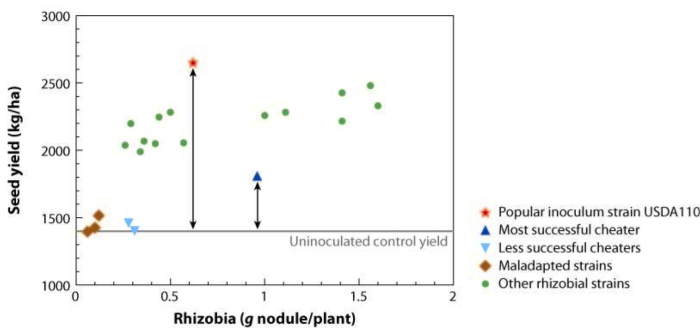Discovery Corner
Legume Series
Research shows that legumes can detect the quality of the rhizobial strains in their root nodules and they have ‘policing’ mechanisms that select for cooperative, nitrogen-sharing rhizobia and against ‘selfish’, carbon-greedy rhizobia.
All organisms require nitrogen which is essential for the production of proteins. However highly abundant atmospheric nitrogen (N2) is only directly accessible to certain bacteria. To take advantage of this, plants, such as those in the family Fabaceae, have developed unique structures called root nodules to house these special nitrogen-giving bacteria. In the legume-rhizobia symbiosis, plants provide root-nodulating rhizobia bacteria with carbohydrates (from photosynthesis) and in exchange, the rhizobia provide nitrogen (fixed from atmospheric nitrogen). This exchange is not free to either organism. Legumes invest as much as 20% of net photosynthate production (6) to supporting their root-colonizing rhizobia and rhizobia share nitrogen they could otherwise be using for self-growth and reproduction. Not all rhizobia provide the same amount of nitrogen and differences can vary by ten-fold (2). Are there consequences to these greedy strains? Yes.
There are many naturally occurring strains of rhizobia in the soil that will colonize legume roots. These different strains can be evident by the differences in the size and number of nodules on a root. What is fascinating from this research is that legume roots can detect, discriminate and ‘reward’ strains that provide more nitrogen while taking less carbon. The cheaters or free-riders are detected by the plant and are punished by getting less carbohydrates from the plants. Figure 1 shows different rhizobia strains and the benefit to the plant (seed yield) compared to the benefit to the bacteria (number of nodules). The most beneficial relationship for the plant is the rhizobia strain that takes the least for itself, producing fewer nodules per plant, while sharing the most with the plant, producing higher seed yield.
Developments in our Understanding of the Legume-Rhizobium Relationship

Figure 1 Benefits of symbiosis to soybeans (seed yield) and rhizobia (assumed proportional to g nodule/plant) for 21 Bradyrhizobium japonicum strains. Horizontal line shows yield of uninoculated control plants. Double-headed arrows show benefits from the popular inoculum strain USDA110 (red star) and the most successful cheater (dark blue triangle). Two other cheaters that obtained less benefit from symbiosis (light blue upside-down triangles) and three apparently maladapted strains that gained almost no benefit (brown diamonds) are also shown. Data from Abel & Erdman (1964); graphical approach suggested by Ezra Lyon (3).
Recommended strains for seed inoculation, such as USDA 110, are those bacteria that share the most nitrogen, while taking the least carbohydrates from the plant. As scientists continue to understand this relationship, optimal strains used for inoculum can be identified and made available to growers.
Toby Kiers, researcher at VU University in Amsterdam (tobykiers.com), calls this the ‘Sanctions Hypothesis’ in which the legume selects for cooperative, nitrogen-sharing rhizobia(4). These sanctions are conceptually analogous to ‘policing’ mechanisms that select for nitrogen-sharing rhizobia and against ‘selfish’, nitrogen-greedy rhizobia. Without such mechanisms, the opportunity for a ‘Tragedy of the Commons’ to occur, where the root is colonized by rhizobia taking carbohydrates from the plant and not sharing nitrogen, is avoided. If greedy bacteria were not ‘punished’, natural selection would work in favor of the greedy rhizobia because they would have more resources to invest in reproduction.
Based on research presented by Dr.Toby Kiers at UC Davis Department of Plant Pathology, October 12, 2015. Kiers received her PhD from UC Davis and is now a professor at VU University in the Netherlands.
REFERENCES
1. Abel GH, Erdman LW. 1964. Response of Lee soybeans to different strains of Rhizobium japonicum. Agron. J. 56:423–24
2. Burdon, J. J., Gibson, A. H., Searle, S. D., Woods, M. J. & Brockwell, J. 1999 Variation in the effectiveness of symbiotic associations between native rhizobia and temperate Australian Acacia: within–species interactions. J. Appl. Ecol. 36, 398–408. (doi:10.1046/j.1365-2664.
3. Kiers, E. Toby and Denison, R. Ford. 2008. Sanctions, Cooperation, and the Stability of Plant-Rhizosphere Mutualisms. Annual Review of Evolutionary Systems, 39: 215-236.
4. Kiers, E. Toby, Rousseau, Robert A. and Denison, R. Ford. 2006. Measured sanctions: legume hosts detect quantitative variation in rhizobium cooperation and punish accordingly. Evolutionary Ecology Research, 8: 1077–1086.
5. Kiers, E. Toby, Rousseau, Robert A., West, Stuart A., R. Ford, Denison. 2003. Host sanctions and the legume–rhizobium mutualism. Nature 425: 78-81.
6. Pate, J.S. 1986. Economy of symbiotic nitrogen fixation. In On the Economy of Plant Form and Function (T.J. Givnish, ed.), pp. 113-126. Cambridge: Cambridge University Press.
